"We have a 9 a.m. meeting? Hold on -- let me just click around the internet like a maniac to find something for the morning tweet."
Sound familiar? Scrambling for social content is nothing new. We have meetings. We run late. Things come up. And it's really hard to get any meaningful amount of work done when you have the next social media update looming over your head every 30, 60, or 90 minutes. It all moves so fast that you might periodically feel a case of the vapors coming on, which is why pre-scheduled social media content should be your new best friend.
To make social media content easier for companies to plan and schedule across the accounts they manage, we created a social media content calendar template. And recently, we updated to be better, faster, stronger, and just generally prettier.
You can fill it in at the same day and time every single week to prep for the following week's social media content. That means when you burst through the office doors at 9 a.m., you won't be in panic mode looking for something to push out to your Facebook fans -- you already took care of that last week.
This blog post will walk you through exactly how to use the template to stay on top of your social media content planning for Facebook, Twitter, LinkedIn, Instagram, Pinterest, and Google+.
Note: HubSpot customers can also schedule content through Social Inbox, or use this spreadsheet to organize their content and subsequently upload it to Social Inbox. Detailed instructions for doing this exist in the cover sheet of the template.
How to Use the Social Media Calendar Template to Plan Your Content Schedule
When you open up the social media content calendar template, you'll notice the bottom of the Excel spreadsheet has several different tabs, most of which are dedicated to a specific social network.

The reason you'll want a different worksheet for every social network is simply that every social network is a little bit different. You can't just craft one, single social media update and use it across LinkedIn, Facebook, Twitter, Instagram, Pinterest, and Google+. You can certainly promote the same piece of content across all six of those networks, but that doesn't mean you'll craft your update in the same way for every single one of them. (In fact, you may even want to add additional tabs if you're active on other networks, like Quora or YouTube.)
This following sub-sections will walk you through how to fill out each of the four tabs you see in this template -- the updates for Twitter, Facebook, LinkedIn, Instagram, Pinterest, and Google+. But before we get to that, let's just walk through the "Monthly Planning Calendar" so you know what that's for.
Monthly Social Media Schedule
The tab "Monthly Planning Calendar" provides an overall snapshot of your monthly social media campaigns. It'll help you coordinate better with other stakeholders, not to mention keep all the moving parts straight in your own mind. Here's what it looks like:
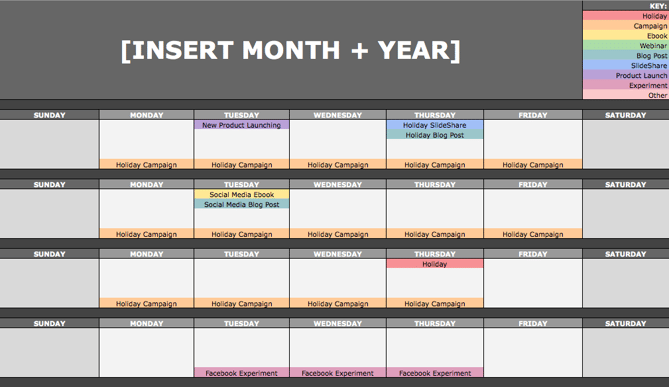
There are three sections to take note of when you edit this template for your own purposes. First, the color-coding key: These are the types of content or campaigns around which you might coordinate, like ebooks, webinars, blog posts, product launches, and so on. Though only some of these might be relevant to you, they're there to indicate what you may want to put in there -- so be sure to edit these categories to align with your own campaigns.
The other two sections you'll need to edit are the Month and Year at the top of the calendar (duh), as well as the cells below each day of the week. In those cells, you should enter the type of content you'll be promoting that day and color-code it to align with the campaign it's supporting.
Instead of deleting all the content in this spreadsheet each month, I recommend copying this worksheet twelve times over, and creating a separate sheet for each month. (If that gets to be too overwhelming, you can always save those tabs as a separate file.)
Planning Your Twitter Content Calendar
Alright, now let's get to the social media content. This section will be the lengthiest, because all subsequent sections will draw on the instructions we go through here. So if you read one section in this whole post, make it this one.
Let's say you want to add some tweets to your scheduling template. Skip over to the "Twitter Updates" tab, where you'll see this:
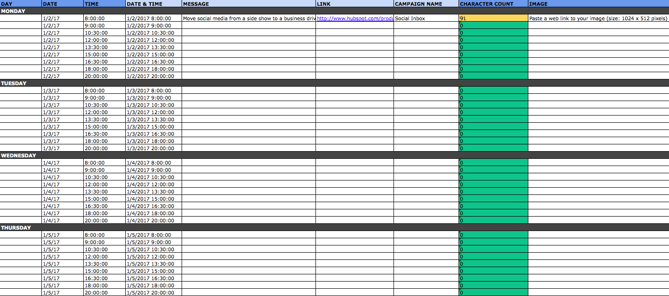
The first four columns, "Day," "Date," "Time," and "Date & Time" are there for your convenience, and if you choose to use a third-party app for pre-scheduling your tweets (like HubSpot's Social Inbox), then these columns will be useful. For now, just fill in the date on which you'd like your updates to publish to Twitter, and the time at which you'd like them to go out. The "Date & Time" column will automatically change based on what you input in the previous two columns.
Now, let's move over to the "Message" column. Here, input the copy you'd like to appear in your tweet, bearing in mind you should cap it at 116 characters to allow enough room for a link, and at 115 characters to allow room for an image. (Read this blog post for a full character count guide.) This spreadsheet will auto-calculate the number of characters you've entered to keep you on-point, turning yellow when you've reached 95 characters, and red when you've reached 116 characters.
After you've composed your tweet, paste the URL you'd like to include in your tweet in the "Link" column. Be sure to include UTM parameters so you'll know whether all of these tweets are actually driving traffic, leads, and customers. This is an important step to remember if you'd like to be able to demonstrate ROI from social. You can also use the "Campaign" column to add an associated campaign, which helps which more robust tracking and reporting.
Finally, in the "Image" column, attach the tweet's image (if you have one). For Twitter, we recommend images that are 1024 x 512 pixels. (Click here for a full cheat sheet of social media image sizes.) If you're having trouble attaching your image to the spreadsheet, follow these steps:
Step 1: Right-click the cell in which you'd like your image.
Step 2: Click "Hyperlink," then click the "Document" button, and finally, click "Select" to choose your image.
Step 3: In the "Choose a File" window, select the image from your computer and click "Open."
Step 4: You'll now see the image attached to the "Insert Hyperlink" screen. Feel free to edit the "Display" text to change the file name, then click "OK."
Note: This process is simply for organizational purposes. If you decide to upload the spreadsheet to your social media publishing software, it will not attach -- you'll have to do that with your marketing software. If you're a HubSpot customer, details for how to bulk upload your Twitter content to Social Inbox can be found within the downloaded template.
Planning Your Facebook Content Calendar
Now, let's talk about how to plan your Facebook marketing in advance with the template. Navigate on over to the tab in your template labeled "Facebook Updates."
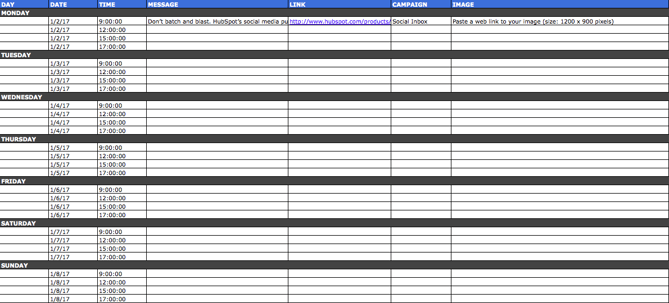
Facebook updates work similarly to Twitter updates, with the exception being bulk uploading your content is not possible in Social Inbox.
The first three columns, "Day," "Date," and "Time" are there for your convenience. Head on over to the column labeled "Message" and input the copy you'd like to appear in your status update, corresponding to the days and times you'd like those updates to run. Then, move to the "Link" column and input the link you'll be, you know, linking to in the update. (Don't forget that tracking token.) If you'd like the update to be tagged to a certain campaign, include this in the "Campaigns" column. Finally, attach an image just like you did with your Twitter updates -- if you're using one, we suggest you edit it to be 1200 x 900 pixels. (Click here for a full cheat sheet of social media image sizes.)
Planning Your LinkedIn Content Calendar
LinkedIn updates are the most unique, because you have both Company Pages and Groups to consider. To demonstrate the difference between Company Page updates and Group updates, let's navigate over to the column labeled "Title (For Group Discussions Only)."
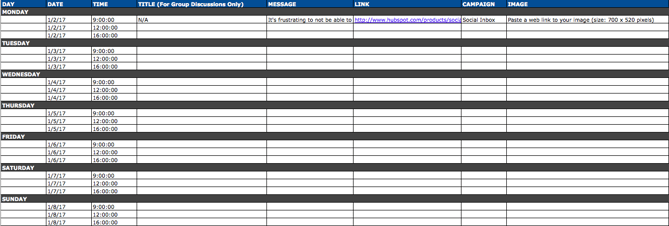
LinkedIn Groups let you post a few kinds of updates, one of which is called a "Discussion." You will only fill out the "Title (For Group Discussions Only)" column if you're looking to post a Discussion to your LinkedIn Group -- because Discussions are the only update you'll be posting that requires a title. If you're not posting a Discussion to a LinkedIn Group, you don't need to fill out this field, because your update will not have a title.
You'll fill out the next column, "Message," for every type of update you post, whether it's for a Company Page or a Group. Simply input your copy into this column, and then navigate to the next two columns, "Link" and "Campaign" to input the URL to which you're directing readers with the tracking token you'll use to track activity, and the associated campaign if one exists. If you'd like to use an image for an update, attach it per the instructions laid out in the "Twitter" section. We recommend editing the image to 700 x 520 pixels.
Planning Your Instagram Posting Calendar
Now, let's move on to how to set up your Instagram photos and videos in advance with the template. Navigate on over to the tab in your template labeled "Instagram Updates."

Instagram updates work similarly to Facebook updates, in that content can't be uploaded in bulk to Social Inbox like it can with Twitter.
The first three columns, "Day," "Date," and "Time" are there for your convenience. Head on over to the column labeled "Message," and input the copy you'd like to appear in your post's caption, corresponding to the days and times you'd like those updates to run. Keep in mind that although Instagram captions can be up to 2,200 characters long, they cut off in users' feeds after three lines of text. The exact length of these three lines depends on the length of your Instagram handle. (Read this blog post for a full character count guide.)
Next, move to the "Link for Bio" column and input whichever link you plan to put in the bio when you publish the accompanying Instagram post. (The reason you'd put a link in your bio and not the photo caption itself is because clickable URLs aren't allowed anywhere except the single "website" box in your bio. See #13 in this blog post for more on how that works.) Oh, and don't forget that tracking token.
If you'd like the update to be tagged to a certain campaign, include this in the "Campaigns" column. Finally, attach an image just like you did with your other social media updates -- we suggest you edit it to be 1080 pixels x 1080 pixels. (Click here for a full cheat sheet of social media image sizes.)
Planning Your Pinterest Content Calendar
Alright, now let's go over how to set up your Pinterest pins in advance with the template. Navigate on over to the tab in your template labeled "Pinterest Updates."
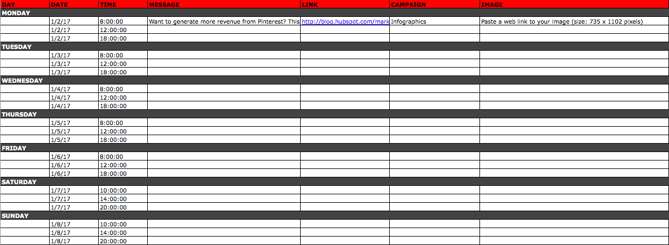
Pinterest updates work similarly to Facebook and Instagram updates, in that content can't be uploaded in bulk to Social Inbox like it can with Twitter.
The first three columns, "Day," "Date," and "Time" are there for your convenience. Go to the column labeled "Message," and input the copy you'd like to appear in your pin's description, corresponding to the days and times you'd like those updates to run. Then, move to the "Link" column and input the link you'll be, you know, linking to in the update. (Don't forget that tracking token.)
If you'd like the update to be tagged to a certain campaign, include this in the "Campaigns" column. Finally, attach an image like you did with your other social media updates -- we suggest you edit it to be 735 pixels x 1102 pixels.
Planning Your Google+ Posting Calendar
Finally, we come to Google+.
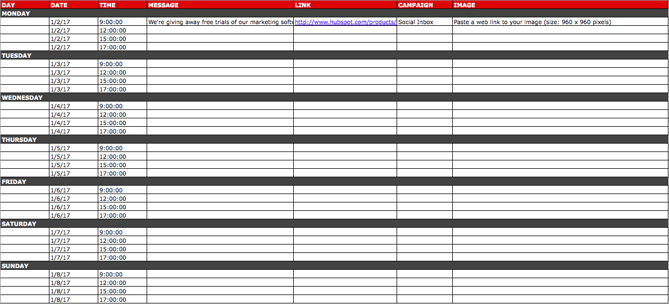
Update: Google recently announced it is shutting down its Google+ platform. Please consider using the template and instructions below for any potential social networking platform Google launches in the future, and check back with us for an updated template that reflects this rollout.
Start in the "Message" column, and input your status update. Then move over to "Link" column, where you'll input the link to which you're directing readers. If you'd like the update to be tagged to a certain campaign, include this in the "Campaigns" column. If you're attaching an image, you could use multiple different sizes, but 960 pixels x 960 pixels works best. (Click here for a full cheat sheet of social media image sizes.)
Content Repository (Or, Where to Source Social Media Content)
This template also provides you with a tab called "Content Repository," which should help you keep track of all your content and maintain a healthy backlog of fodder to make sourcing social media content easier.

As you create more assets, you'll likely want to resurface and re-promote those pieces down the line, too. To ensure you don't lose track of all of that content, record it on this tab so you're never at a loss for what to publish on social. If the content you're promoting isn't evergreen, be sure to include an expiration date in the column marked "Expiration" so you don't promote it when it's jumped the shark.
This tab will also help you maintain a healthy balance of content: A mix of your own content and others', a mix of content formats and types, and mix of lead generation content vs. MQL-generating content vs. traffic-friendly content.
Don't Forget to Interact With Your Followers
Whether you use this spreadsheet to plan your content out in advance or upload to a third-party app, you'll still need to supplement these updates with one the fly content. Breaking news hits? Whip up a quick update to share it with your network. Someone in your network tweets something interesting? Give it a retweet with some commentary. Got a fascinating comment on one of your updates? Respond with a "thank you" for their interaction or an additional follow-up comment.
Coming up with and scheduling your social media content in advance is a huge time-saver, but it should go without saying that you still need to monitor and add to your social presence throughout the day.
Finally, we encourage you to experiment with your social media publishing. This template provides publishing dates and times for each social network, but you may find those are way too many updates for you to fill, or perhaps too infrequent for your booming social presence. You should adjust your social media publishing frequency as needed.
from Marketing https://ift.tt/2j637rw
via
No comments:
Post a Comment